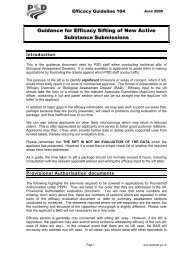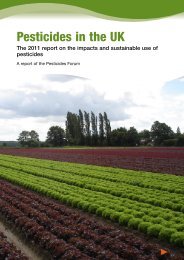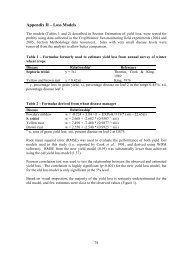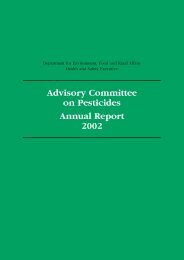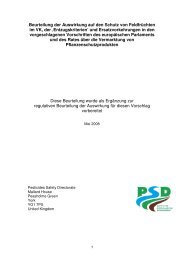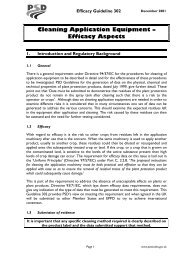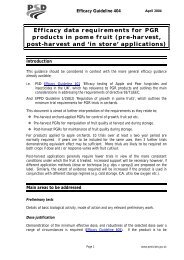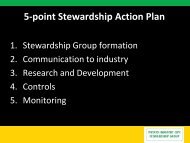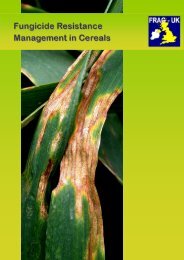Advisory Committee on Pesticides Annual Report 2001
ACP Annual Report 2001 - Pesticides Safety Directorate
ACP Annual Report 2001 - Pesticides Safety Directorate
You also want an ePaper? Increase the reach of your titles
YUMPU automatically turns print PDFs into web optimized ePapers that Google loves.
<str<strong>on</strong>g>Advisory</str<strong>on</strong>g> <str<strong>on</strong>g>Committee</str<strong>on</strong>g> <strong>on</strong> <strong>Pesticides</strong> <strong>Annual</strong> <strong>Report</strong> <strong>2001</strong><br />
The most extensively used fungicide formulati<strong>on</strong>s were copper oxychloride/<br />
metalaxyl, pyrazophos, copper oxychloride, fenpropimorph, zineb and<br />
myclobutanil, which together accounted for 83 percent of the total area of<br />
fungicides used. In terms of weight applied, copper oxychloride was the most<br />
important fungicide formulati<strong>on</strong>, accounting for 31 percent of the total.<br />
Sulphur accounted for six percent of the total area treated and 12 percent<br />
of the weight applied, reflecting its high rate of applicati<strong>on</strong>.<br />
The most extensively used herbicide formulati<strong>on</strong>s were diquat/paraquat, used<br />
mainly for defoliati<strong>on</strong>, sodium m<strong>on</strong>ochloroacetate, again for defoliati<strong>on</strong>, and<br />
simazine and glyphosate, used mainly for general weed c<strong>on</strong>trol, all of which<br />
accounted for 90 percent of the area treated with herbicides.<br />
The most extensively used acaricide was tebufenpyrad, which accounted for<br />
60 percent of the area treated with acaricides and was used mainly to c<strong>on</strong>trol<br />
red spider mites.<br />
72<br />
The most extensively used insecticide was imidacloprid, which accounted for<br />
81 percent of the insecticide-treated area, applied primarily to the ‘hills’ in the<br />
hop garden or yard. Insecticide usage had decreased by 23 percent from that<br />
in 1996 and by 80 percent from that in 1992. The decrease in insecticide usage<br />
overall reflected dramatic declines for all major insecticide groups including<br />
carbamates, organochlorines, organophosphates and pyrethroids. The<br />
introducti<strong>on</strong> of imidacloprid has radically changed insecticide usage <strong>on</strong> hops,<br />
with a single applicati<strong>on</strong> <strong>on</strong> many crops being made early in the year to give<br />
all-seas<strong>on</strong> c<strong>on</strong>trol of the dams<strong>on</strong>-hop aphid Phorod<strong>on</strong> humuli (Schrank).<br />
The area treated with defoliants and tar oils combined accounted for three<br />
percent of the total area treated and 30 percent of the weight applied in 2000.<br />
The use of tar oil as a defoliant had decreased by 79 percent since 1996 in<br />
terms of area treated and by 84 percent of weight applied, reflecting the<br />
c<strong>on</strong>tinued move towards anthracene oil as a defoliant.<br />
<strong>Report</strong> 179: Farm grain stores in Great Britain 1998/1999<br />
This report presented data from 1,858 replies from a preliminary questi<strong>on</strong>naire<br />
sent to 2,997 arable holdings in Great Britain and the results from visits to<br />
444 holdings both using pesticides and storing grain from the 1998 harvest in<br />
Great Britain. Data had been extrapolated to give nati<strong>on</strong>al estimates of usage<br />
in Great Britain.<br />
A total of almost 18 milli<strong>on</strong> t<strong>on</strong>nes of grain was stored of which 74 percent<br />
was in flat stores, and the remainder being stored in bins or silos.




